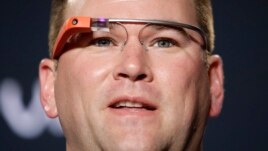18 January, 2014
Welcome to As It Is, from VOA Learning English. I'm Steve Ember in Washington.
Today on the program, Google Glass was a big hit at the recent International Consumer Electronics Show in Las Vegas, Nevada.
"Google Glass is a tiny computer that sits in a lightweight frame and rests neatly above your eye. And it makes exploring and sharing the world around you a lot easier."
The glasses are still being tested. But they can now be purchased by users of the Google Play Music service. The cost: about $1,500. We will hear more about this wearable technology later in the show.
But first, many high-tech companies are busy developing the next generation of electronic devices. These products will help us drive our cars, buy goods and even care for our children! We have more on the story from our technology reporter, June Simms.
Tech Company Intel Looks Toward the Future
The technology company Intel recently held a demonstration of some of its new devices in San Francisco. One device measured how alert a driver was at the wheel. Sensors attached to the driver's head measured brain activity. Cameras placed on the car's dashboard measured eye movement.
Intel Labs' Justin Rattner says devices like these will make driving safer.
"We're not monitoring brain waves. We're seeing how much of the brain is occupied in a given situation, how much of the brain is occupied when you're driving your car, or when you're driving and trying to send text messages."
Another experimental Intel technology links cars electronically to help prevent crashes. When the driver of the car in front signals a turn or slows down, an alert message is sent to the car in back.
There was also a demonstration of a virtual machine.
"You can zoom out ..."
The machine was projected onto the table from a controller hidden in a flower pot. Sensors read the movements of the users' hands, so there was no need for a mouse or other handheld device.
At the market, sensors and computer chips placed in products could help shoppers find the items they want. It could also help them avoid items they might be allergic to.
Cameras and sensors are already available to help parents watch their children. More advanced monitors will one day check the baby's health and mood.
And security systems are being improved and simplified, with face-recognition software instead of complicated passwords. Paul Schmitz of Intel Labs says a simple device like a mobile phone could provide multiple levels of security.
"And that could be in terms of voice, it could be in terms of a 3-D facial scan so that you can make sure that it really is me and not somebody holding up a picture of me."
Mr. Schmitz says new forms of encryption will make high-tech systems harder to hack.
Justin Rattner says new technology brings with it new concerns about privacy and data protection. He says Intel takes these issues very seriously. But he also says growing computing capacity, used in imaginative ways, is already changing our lives and will change them even more in the future.
"It this steady advance of chip technology that makes all of these other devices and services possible."
You are listening to As It Is from VOA Learning English. I'm Steve Ember.
The Internet company Google continues to test its newest high tech device, Google Glass. Google hopes to make the product available to the public later this year. Here is June Simms with more.
Testing on Google Glass Continues
Chris Dale is the Senior Manager of Communications for Google Glass.
"Google Glass is a tiny computer that sits in a lightweight frame and rests neatly above your eye. And it makes exploring and sharing the world around you a lot easier."

Stanford offensive coordinator Mike Bloomgren, wearing Google Glass, answers questions from the media during a news conference, in Los Angeles.
Professor Marcia Dawkins is among a select group of people who have been given a chance to test out Google Glass.
"I thought this is something I definitely need for my classroom and hopefully for my personal life too."
The professor's Google Glass looks like bright orange glasses, without the actual glass. But there is a tiny rectangular glass at the top right hand corner. Through that glass, she has been recording video while biking. She also has been able to talk to her sister in Thailand.
But not everyone is excited about Google Glass. Some are concerned about possible risks to privacy. John Simpson is the director of the privacy project at Consumer Watchdog.
"It is essentially going to allow people to come in and spy on you and record that without you knowing what is going on."
Google says that it has already addressed that concern. Mr. Dale explained that in order to start the camera or record a video, the owner must say something out loud.
"I activate the device, and say ‘Okay, glass, take a picture.' Similarly, I have a little button on the top here that I can push that will again show an explicit gesture to everybody around me that a picture is being taken or a video is being recorded."
But filmmaker Chris Barrett showed just how easy it is to record people without them knowing it. His Glass captured a man getting arrested after a fight. He shared the video on YouTube.
Also, some are concerned about the use of facial recognition technology on Google Glass. But Google says it will not approve the use of such applications.
And that is As It Is for today. I'm Steve Ember. Thanks for joining us! And for the latest world news, be listening to VOA at the top of every hour, Universal Time.